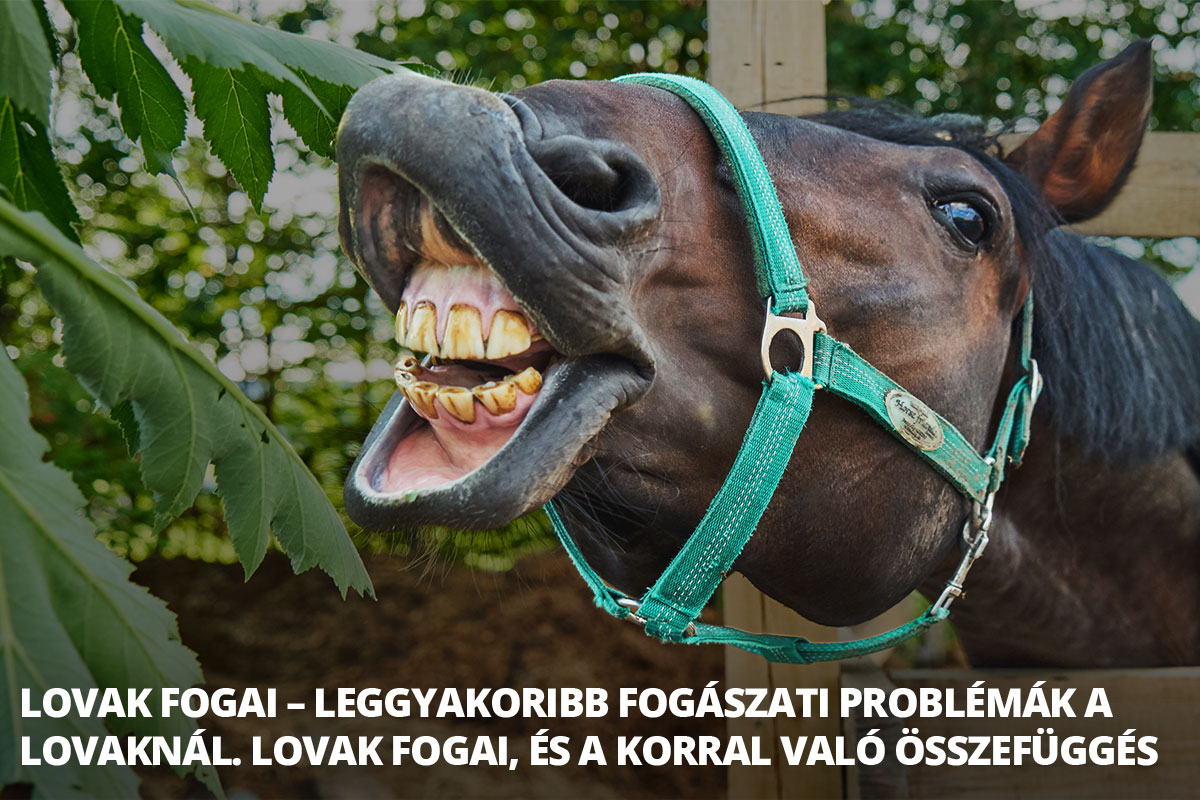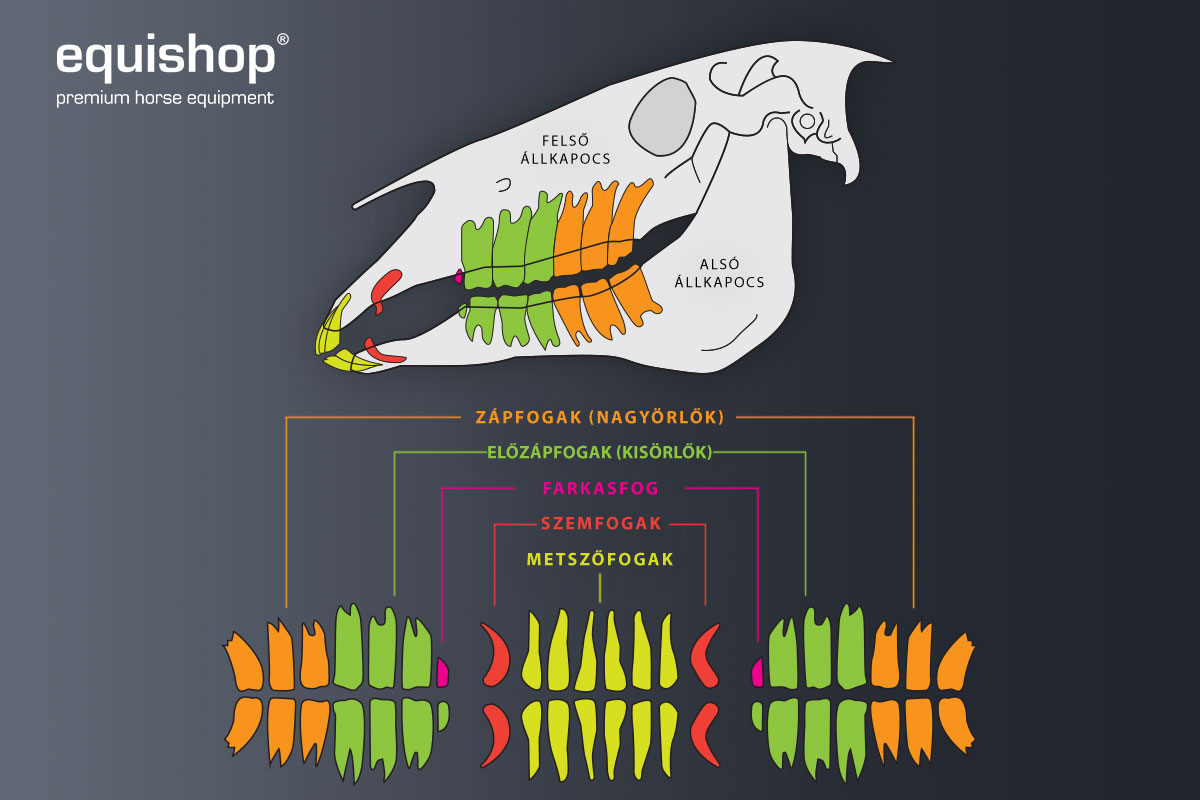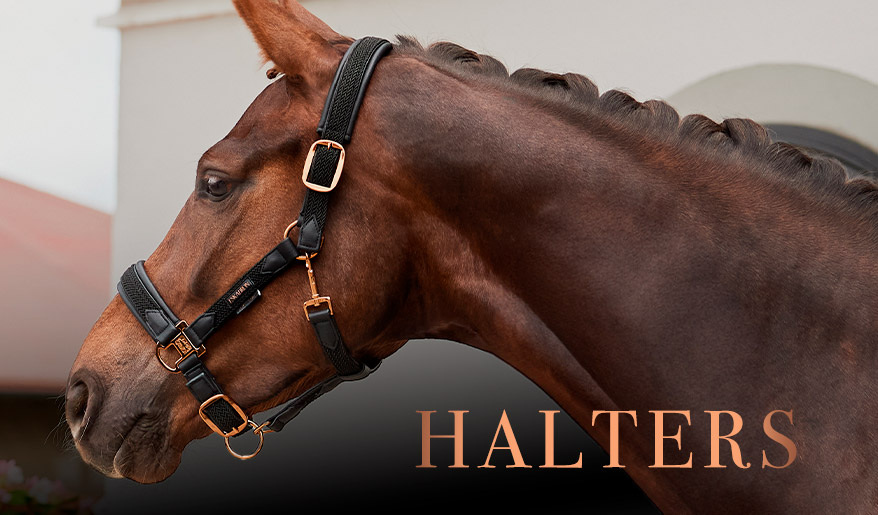
Ha belenézünk egy ló szájába, sok információt kaphatunk az állatról, többek között: milyen korú vagy milyen az egészségi állapota.
Érdemes rendszeresen ellenőrizni lovaink fogait, hogy a farkasfogak nem zavarják-e a zabla rágását, vagy hogy a fogak éles szélei nem sértik-e fel a szájpadlást evés vagy lovaglás közben.
Fogak kinézete, és korral való összefüggésük

Minden állatorvos, zootechnikus vagy tapasztaltabb lovas képes meghatározni egy ló hozzávetőleges életkorát, pusztán az elülső fogakra nézve.
A lovak egész életük során folyamatosan változtatják fogaik számát és azok kinézetét is - a kor előrehaladtával a tejfogak állandóvá válnak, illetőleg idővel elhasználódnak, elkopnak, valamint változtatják alakjukat.
Mire figyeljünk oda?
A lovak fogai egész életük során nőnek, azonban természetes módon kopnak is folyamatosan. A kopás mértéke évente körülbelül 2 mm.
A fogak dőlésszöge, valamint a metszőfogkoronák és a betüremkedéses mélyedés (kupa) alapján felmérjük az állat életkorát. Ha egy ló 2 és 5 év közötti, akkor elég pontosan meg lehet állapítani az életkorát, ha megfigyeljük a fogak adott részeit, melyek megfelelő sorrendben cserélődnek ki.
Ha gondosan megfigyeljük a metszőfogak koronáját, észrevesszük, hogy a fog rétegei idővel növekednek. A több rétegmennyiség jelzi a ló korát.
A ló életkorának egyik legfontosabb mutatója a kupa, vagyis a fogak üregei. Ők azok, amelyek sekélyebbé válnak – minél kisebb a mélyedés, annál idősebb a ló.
A maradó fogakban mélyesdések figyelhetők meg, az alsó állkapcson körülbelül 6 mm, a felső állkapcson 12 mm. A bemélyedések 11-13 éves korban teljesen lekopnak, és ezt követően egyre nehezebb meghatározni a ló korát.

A csikóknak 2 hónapos korukban már kihasadnak tejfogaik , amelyeket 2-3 éves koruk között maradó fogakkal helyettesítenek.
Előfordul, hogy az idősebb lovaknak tejfogaik vannak, ekkor javasolt a fogorvos felkeresése.
A tejfogak könnyen felismerhetők – csésze alakúak és kifejezetten fehér színűek, míg a maradandó fogak megnyúltak illetve inkább sárgábbak.
A fogak cseréje a metszőfogak, azon belül is a fogófogak cseréjével kezdődik (kb. 2,5 éves korban), majd ezután a középfogak cseréje (kb. 3,5 éves kor), végül a szegletfogak cseréje történik.
Egy ötéves lónak már teljes állandó fogazata van.
A maradó fogak üregei (kupái, regiszterei) egyre kevésbé észrevehetők. A mandibulán elhelyezkedő metszőfogakon a bemélyedések teljesen elkopnak, a felső metszőfogakon még látható egy kis bemélyedés. Idővel illetve az állandó kopással a fogak háromszög alakúakká válnak.
Az összes fog kupái eltűnnek, mind a felső, mind az alsó állkapocsban.
A fogazat állapota folyamatosan változik, a lovak fogainak alakja háromszögből ovális-hosszúkásra változik.
Mik a leggyakoribb fogászati problémák a lovaknál?
A lovak nem mindig mutatják ki, hogy éppen kényelmetlenül érzik magukat, ezért könnyű figyelmen kívül hagyni azokat a riasztó jeleket, amelyek rossz fogászati egészségre és fájdalomra utalhatnak.
Ennek ellenére észrevehet bizonyos tüneteket, amelyek figyelmeztethetnek a fogágybetegségre vagy más súlyos betegségekre.
Ha azt észleljük, hogy lovon az alábbi tünetek bármelyike jelentkezik, feltétlenül hívjunk állatorvost/lófogorvost, aki gondosan megvizsgálja a ló száját:
probléma a zabla bevételével / nem szívesen veszi be a szájába a zablát,
kinyújtja, kidugja a nyelvét lovaglás közben,
meg nem evett takarmány az etetőben / nem szívesen fogyasztja a táplálékot,
emésztetlen táplálékdarabok a trágyájában,
hirtelen testtömeg csökkenés,
észrevehető állkapocs befeszülések,
vonakodás az előrehaladástól,
apátia / lelogó fülek.
Ha a fenti tüneteket észleljük, forduljunk állatorvoshoz, aki esetlegesen megerősíti a betegség lehetséges előfordulását.
A rendszeres fogorvoslátogatás (legalább évente egyszer, ideális esetben 6-9 havonta) kulcsfontosságú a probléma észleléséhez, még akkor is, ha a ló nem mutatja a fájdalom jeleit.
Melyen fogászati problémákkal találkozhatunk a leggyakrabban?
Farkasfog - Nem minden lóban jelennek meg a farkasfogak, de ha észrevesszük őket, azonnal hívjunk lófogorvost, hogy távolítsa el őket. A farkasfogak leggyakrabban a mandibulán (alsó fogívben) találhatóak, és közvetlenül az előzápfogak előtt, azaz a zabla helyén helyezkednek el.
Kampóképződés – a kampók a helytelen szájzáródás következménye, amelyben a ló fogai egyenetlenül kopnak. Ez a pofafogakkal kapcsolatos probléma, amelyek a kiálló (felső vagy alsó) fogak problémája miatt nem kopnak el teljesen.
Tejfogak - előfordul, hogy a tejfogak nem esnek ki, és helyükön állandó fogak nőnek ki. Ez azt a helyzetet okozza, hogy a tejfog a fogak közé préselődik, ami nagy fájdalmat és kényelmetlenséget okoz. Ebben a helyzetben gyakran műtétre van szükség.
Éles fogélek – szinte minden lónál előfordulnak, és reszelést (csiszolást) igényelnek. Az állkapocsban lévő fogak külső részei (felső fogak) gyakran nem egyenletesen kopnak, mivel az állkapocs valamivel szélesebb, mint a mandibula. Az éles szélek fájdalmat illetve kényelmetlenséget okoznak, és megsértik a ló pofáját valamint nyelvét.
Suppuráció – a fog gyökere körül megjelenő gennyes tartalom, mely rendkívül fájdalmas és veszélyes a ló számára, illetve azonnali műtétet igényel. A genny általában a zápfogak és az előzápfogak területét fedi le.
Szemfogak – A szemfogak a csődörökben találhatóak, és élessé válhatnak, gyakran fájdalmat okozva. Rendszeresen ellenőrizni és reszelni (csiszolni) kell őket.
Ha egy állatorvosi látogatás alkalmával kiderül, hogy lovadnak bizonyos szájzáródási rendellenessége van, akkor félévente ellenőrizni kell, mert gyakrabban van kitéve a fogászati betegségeknek.
Pár érdekesség
Egy felnőtt ménben 40 fogat tudunk összeszámolni, egy kancában pedig csak 36-ot! Miért? A méneknek 12 metszőfoga, 24 őrlőfoga (őrlőfogak illetve kisörlőfogak) és 4 szemfoga van, míg a kancáknak nincs szemfoga.
A zabla helyén nincs fog! A zabla a ló szájának azon részén fekszik, ahol csak az íny található, közvetlenül a metszőfogak mögött és a premolarisok (előzápfogak) előtt.
A ló fogai több helyet foglalnak el, mint a ló agya.
A csikóknak csak 24 tejfoguk van.
A ló elülső fogait metszőfogaknak nevezik, mert fű tépésére és rágcsálására használják.
Nagyon fontosak az ápolt és egészséges fogak, de nem szabad megfeledkezni a ló szőrének vagy patájának megfelelő ápolásáról sem. Nézd meg a Lóápolás részleget, és szerezd be a legjobb ápolási termékeket.
Hírek az Equishop Lovasboltból:








